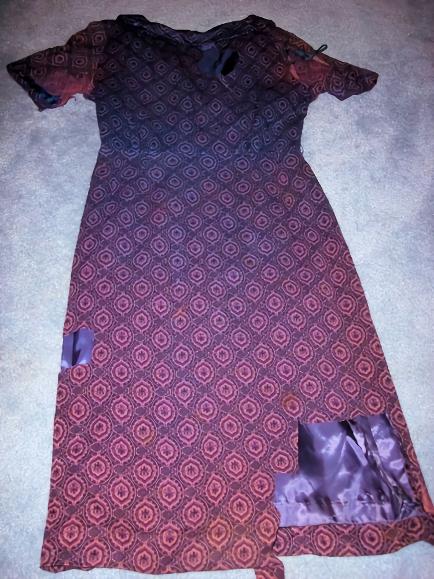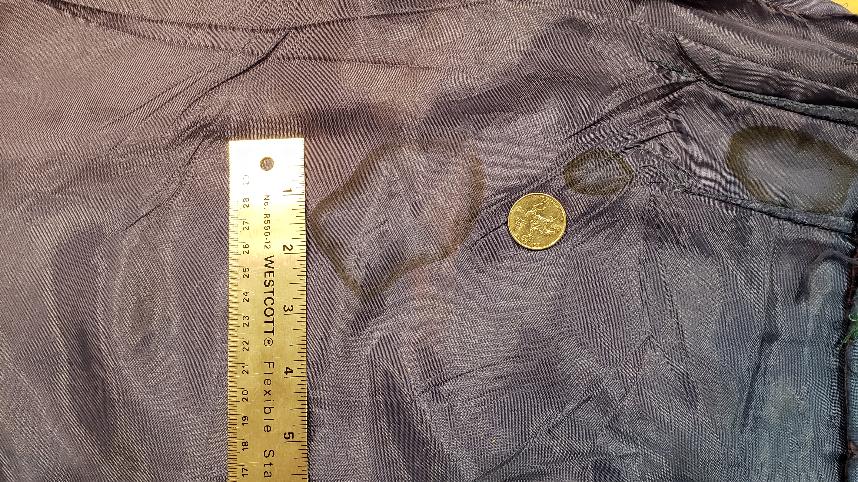©Copyrighted by Kathleen Marden, Trustee of the Betty Hill Trust. All rights reserved.

© Kathleen Marden (2024) All rights reserved.
© Kathleen Marden (2024) All rights reserved.
New Scientific Analysis of Stains and Rare Elements on
Betty Hill's Dress
© Kathleen Marden (2024) All rights reserved
In a 2020 television show, host Ben Hansen and I visited the Milne Special Collections Library at the University of New Hampshire to examine Betty Hill's dress. Ben is a former special agent for the FBI and is now a television producer. I am the trustee of Betty Hill's estate and her legal representative. I compiled the archival collection from Betty's historical record and donated it to UNH. I have the sole right to approve scientific research on Betty's dress and to cut fabric samples from her dress.
Ben noticed several stains on the front lining of Betty's dress that did not penetrate the outer fabric. In other words, they could not have been coffee stains because there were no liquid stains on the exterior of the dress in this particular area, only on the lining. Ben suspected that they were blood stains and requested fabric samples for DNA analysis. I, Betty's legal representative, agreed to cut a stained fabric sample from this area of the lining and send it to a scientific laboratory for analysis. I had retained a filter disk stained with Betty's blood for comparison. I used gloves and clean shears at all times. We wondered if the stained area might indicate that Betty's memory of having a needle inserted into her navel was accurately recalled.
DNA Analysis Report by Lynne Mann
06/15/2020 Case # 10021
"DNA case report on the historical 1961 case of the Betty and Barney Hill abduction. This was a test of
a newly found stain on the Blue dress at about the waistband in the front to ascertain the origin of the
DNA and it's relation to a sample of Betty Hill's blood taken at a later date.
Methods and Instrumentation
The PCR portion of the procedure was accomplished on the Stratagene RoboCycler Temperature
Cycler and a Biorad Thermo mixer. The E gel electrophoresis system with illuminator and using 2%
agarose E gels. All Reagent kits purchased from Thermofisher Scientific of Carlsbad California. The
kit was a new procedural kit Thermo Scientific Phusion Human specimen Direct PCR that has been
found to be effective in procuring DNA from older and minimal samples. All procedures were done
while wearing a head covering, face mask, gloves and lab coat freshly washed and bleached and used
for DNA procedures only. All handling of DNA and any tools used therein were sterilized and handled
via proper Laboratory norms for DNA processing. All vials, pipette tips etc. were sterile as well.
2x3mm punch sample was taken of the stained cloth and processed in a reagent solution provided by
BlueStar Hemoglobin test kit for the presence of blood, The test was found to be negative for blood.
The test was performed twice to insure the testing cassettes were giving a uniform reading. One line
at the C position is an indicator that the reagent used is working as expected. A second line at the T
position would have indicated the presence of blood. Therefore the tests were both negative. Whether it
was due to the age of the sample (1961) or it not being a blood stain but rather a sweat or other bodily
fluid stain the indication was a definite negative for blood.
The Thermo Scientific Phusion Human specimen Direct PCR Kit can be used with several types of samples the negative blood test was not a prohibitor of it's use and the protocol followed from the
kits instruction sheet was as follows:
Two 3mm punches were taken from the material in two different areas of the sample cloth sample
blood sample on paper using tissues punches purchased from Ted Pella Co. they were placed in
separate 1.5 ml vials, one for the dress stain and another for the blood on paper, containing 50 ul
dilution buffer, 1.5 ul DNA-release additive (provided with kit) and 250ul TE (Tris /EDTA) pH 8.
purchased from Thermo scientific. The samples were rotated to loosen stain material and blood then the
cloth and paper was removed using a sterile instrument by pulling them up the sides of the vial and
disposing of them in the proper manner. Both vials were mixed by vortex and spinning them down in a
centrifuge at 10,000 rpm. The vials containing the samples were then incubated at 98 degrees Celsius
for two min., spun down again and 0.5 ul of the supernatant used as a template for a 20ul PCR reaction.
The primers for the PCR reaction were as follows:
Primer #1 (24-mer)
5'- AGCCCTTGGGGASTTGAATTGCTG – 3'
Melting point: 73.5 degrees C
Primer#2 (27 mer)
5'- GCACTCCAGAGGACAGCRGTGTCAATA - 3'
Melting point 72.2 degrees C(R=A), 75.3 degrees C (R=G)
Both primers included in Thermo Scientific Phusion Human specimen Direct PCR Kit
Pipetting instructions for PCR reaction are as follows:
H2O 20ul
2xPhusion human specimen PCR buffer 10ul
Universal control primer mix 0.4 ul
Phusion Human specimen 0.4 ul
DNA Polymerase
Dilution protocol: 0.5 ul
Cycling program for the Robocycler:
98 degree C 5min for 1 cycle (Lysis of cells)
98 degrees C 1s
Denaturation
72 degrees C 15s Annealing/Extension 45 cycles each in succession.
72 degrees C 1min Final Extension 1 cycle
4.0 degrees C Hold
Conclusion
In conclusion the unknown stain and the known blood sample for Betty Hill are a match. Although the
stain read negative for human blood and could have been a sweat stain or so degraded for hemoglobin
it did not register on the blood cassette used for the blood test, it must be concluded that this stain came
from body fluids of the wearer of the dress (Betty Hill)." *Note: sweat stains were not found elsewhere on the dress. (end report)

University of Pittsburgh, Bradford Chemistry Department
XRF Analyses on Three Dress Samples
A tenured chemistry professor with thirty five years experience and his tenured colleague (names withheld), an associate professor with thirty year's experience at the University of Pittsburgh, Bradford, PA, supervised a chemistry major who carried out scans on three samples from Betty Hill's dress. The fabric samples from Betty Hill's dress exterior were mailed to him in separate plastic bags in 1992. He contacted the Kathleen Marden on the morning of on February 7, 2020, stating that one of his students would conduct X-ray fluorescence to detect heavier elements on Betty’s dress. The student had previously carried out scans on various soft pastels from China.
The chemistry professor wrote as follows:
"The student was told nothing until he completed the scans. He used an instrument manufactured by Oxford Instruments (Compact Eco) which is a benchscale instrument. There are models also used in the field by scientists.
The student wrote down the details for each sample in the plastic holders which you sent me.
Waistline: Ti, Mn and Ba were detected (0.5% level can be detected for calcium and heavier elements).
2nd sample: Mn, Ga, Ge and La.
3rd sample: Ti, Mn, Fe, Se, Te and Rh.
The print dress has dyes and mordants holding the dye to the fabric as would be expected. Aluminum salts are often used, and it was not observed. Iron salts can and we saw it on only one sample.
The associate professor and I were amazed at Te and Rh showing up on / in fabric.
Selenium has been used in 1950s era oil-based paints and we have scanned a number of such paints from a company in Cincinnati later purchased by Crayola. We found selenium (very poisonous element) in one such paint. The rare and expensive Rh was observed. It would never be expected in clothing. The same with Te.
I would suggest that more extensive scans be done by a chemistry professor in a graduate chemistry dept. They can corroborate our cursory findings and perhaps detect other elements.” (end report)
Rare Elements Found on Betty Hill's Dress
Tellurium is a very rare element that averages only three parts per billion in the Earth's upper crust. It is more prevalent in space. It shows a close association with gold and may be present in ore bodies of most gold deposit types at levels of tens to hundreds of parts per million. However, orebodies likely have concentrations of 0.1 to 1.0 parts per million. Although it is rare in the Earth's crust, it is far more prevalent in the universe. (Tellurium-USGS Publications, pubs.usgs.gov/publication/pp1802R
The most valuable precious metal on the planet, Rhodium is also the rarest element. It makes up only 0.0002 parts per million of the earth's crust. It is resistant to corrosion with a high melting point and is an excellent catalyst. It is durable and resistant to heat, wear, and corrosion. " (www.theassay.com, http://science.howstuffworks.com)